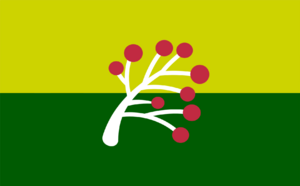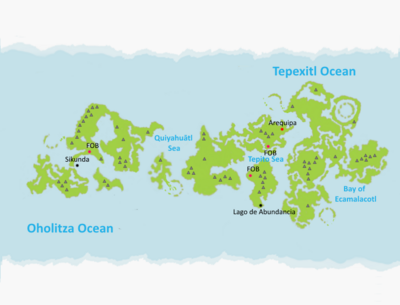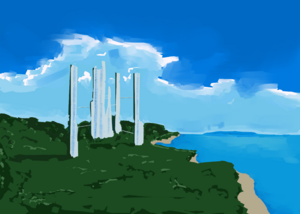Mictlan
A primarily aquatic world with jungle-speckled Islands making up all of its geological landmasses. Mictlan’s poles are insignificant compared to Earth’s. This, and other evidence, leads scientists to believe that the planet was originally not aquatic in nature but more Earth-like in the past.
The planet is a democratic state with the highest echelons being dominated by local corporate and Idris money and power, while not as extreme as Eridani or Biesel, it was an outlier among the Solarian planets. This has led to stratification, with most of the population living on oceanic installations while tourists and corporate sponsors enjoy their life on the little mainland there is.
While Mictlan is been a beacon of multiculturalism among humans and aliens in the Orion Spur, many humans that have immigrated to the planet have been assimilated into Mictlan's culture and society. Because of this, human characters born on Mictlan must have names and appearances consistent with the peoples of Central and South America. Only characters native to Mictlan may take the Mictlan accent. This is enforceable by server moderators and admins.
Flora and Fauna
Although initially a worry of some scientific communities, the native species of Mictlan have formed symbiotic relationships with the foreign species, baffling the settlers. Those that haven’t are considered protected, and it’s illegal to hunt them or attempt to domesticate them. Xenobiology is a popular field in Mictlan, with the Tupac Amaru University having coordinated efforts with the Skrell to study many of them that hide deep in the jungles and swamps.
The official animal of Mictlan is referred to as the Aztlanian llama. This animal is the most characteristic species of Mictlan with a longer neck than its human counterpart, an affinity for submerging in baths almost daily, and a protective layer of water-resistant fur covering their soft and heat-insulating wool. Another important species is Buxton’s Alpaca, a hybrid of llama and alpaca: with their willingness to work, nutritious meat, and luxurious wool, even the poorest settlers of Mictlan found their place on the planet. Both the hybrid and the common Mictlanian llama have thermic adaptive properties, which are known for being fresh in the summer and retaining the heat in the winter. The popularity has also created a growing industry of textiles in Mictlan with many corporations competing to dominate this market galaxy-wide.
A native domesticated animal is the Arequipan cow. While only vaguely resembling their earth counterpart, they are similar in that they provide the settlers with milk. This milk has unique properties that even lactose-intolerant individuals can ingest without issue. The main crux is the Arequipan bull, a male member of the species that are extremely territorial and aggressive. According to polls, Arequipa bulls are responsible for 15% of deaths in the farming industry.
Flora-wise the large amount of insects present on Mictlan seem to have contributed to their assimilation into the local ecosystem. Establishing evolutionary links that would have otherwise taken millions of years to develop in less than a century. This allowed Mictlan to produce harvests much sooner than other settlements and acquire food independence early on. Currently, the largest harvests come in the forms of wine and coconut oil.
Population and Society
According to the most recent polls conducted in 2457, Mictlanian society boasted the largest amount of Xenos in Solarian society but with their inclusion in the Republic of Biesel, they have been trumped by Biesel. Regardless, Mictlan remains very popular among all alien species and the society and government of Mictlan are much less judgemental of these foreign immigrants, though the majority of the planet's population is human. Among the most numerous are Skrell, followed by Unathi, and finally Dionae. Sol Common is the official language of Mictlan and is spoken by nearly all of its human population, however Tau Ceti Basic is a second language that most, alien or human, on the planet know in order to communicate with the other species on Mictlan. Tradeband is also spoken on Mictlan and was historically used to communicate between different species. Despite this, it is not considered an official language of the planet and is more seen as a relic from the planet's early colonial days. Its number of speakers has begun to decline as Tau Ceti Basic has gained rapid popularity among humans and aliens alike on the planet in recent years.
Most of the population lives on metallic oceanic constructions that have been established since the first settlers arrived. These sturdy buildings have been expanded over time and now entire cities rest on their plasteel shoulders. While breakdowns are not uncommon, a major accident has not occurred in 50 years and these cities are just as safe as any other. The mainland, the little there is, is mostly reserved for natural reserves, agriculture, and rich corporate sponsors and tourists. Most Mictlanians never step on the soil of Mictlan throughout their lives.
History
Mictlan was not the original target for the South and Central American colonists whose descendants now inhabit it, instead, it became an accidental one after they were forced into an emergency landing. The captain of the original colonization fleet, codename: Tlaloc, whose name has been removed from the records to protect his descendants, excessively mishandled the allocation of resources during their long voyage, focusing more on the comfort of the first-class clientele. This had resulted in a lack of fuel, food, and other resources that forced them to make an emergency landing two years prior to reaching their intended target.
The colonists already lacked the expertise and technology to comfortably adapt to an aquatic planet, and with the captain’s refusal to change his behavior casualties mounted. An attempt was made to challenge the captain’s leadership by contacting the Sol government, however, the continued failures of the colonists to meet quotas led to them being largely ignored. Thus a revolution was inevitable. During this insurrection, the captain alongside other colony heads was murdered, and the newly appointed government began calling itself the Movimiento Fundación. This explosion of violence finally caught the interest of the Sol government, who immediately sent out an armed force to rescue the survivors and re-establish law and order.
The movement did not last long against such an overwhelming force and democracy was re-established. A new head for the colony was chosen and with the continued efforts the possibilities of underwater logging and uranium mining became apparent, corporations began to invest in Mictlan, building up infrastructure and worker force. During this time, the newly established colonial government led a “War on Waste”, to preserve the natural beauty of Mictlan. This included the nationalization of small private businesses that created too much waste, higher fees to secure intellectual property rights, and the introduction of new fines targeting the Mictlanians for littering. It was clear to the colonists at the time this was a transparent attempt to prevent a surge of small-time businesses but with an armed force present, the concerns went unvoiced.
Today, Mictlan is a democratic state like many others and until recently one of the many planets belonging to Sol. Its beautiful and verdant landscapes, largely undisturbed by the usual tinkering and biome modification, provide a great source of rich tourists who wish to see nature in its rawest and also safest state. Bountiful aquaculture and agriculture create an environment of rich harvests and excess fruit production and the great Uranium deposits allow for constant streams of credits to enter the economy. Still, the planet is plagued with hostile laws targetting those who would wish to strike out big, most of the excess food is exported and very few of the locals get to live in the luxurious hotels dotting the large cities. This issue has only increased in recent years, as misleading marketing has led to many aliens hoping for a better future in Mictlan, ultimately ending up stuck in the lower rings. With a corporate structure choking out any attempts to ascend the social classes.
Peacekeeper Mandate
Mictlan Defense Force
The Mictlan Defense Force can trace its origins back to the original enforcers of Captain Tlaloc, who were at first just security officers aboard the ship. The Captain trained and equipped them to be a more paramilitary force that was used extensively to subjugate the colonists during Mictlan’s early years. During the revolutionary period, most of the organisation’s officers were tried and executed for their part in aiding Captain Tlaloc’s tyrannical regime, while the rank and file soldiers were integrated into the Revolutionary Armed Forces of Mictlan. The Revolutionary army was not as organised as its predecessor and quickly capitulated to the Solarian Alliance’s forces, being reorganised into the Mictlan Defence Force.
Because of Mictlan’s location within the Sol Alliance, the Defense Force was always a small and unutilised force. Deep within Solarian space, the planet had no need for a large standing army, which resulted in them being underequipped and underqualified to handle any major emergencies. This became evident in late 2462 when the economic and territorial collapse of the Sol Alliance left Mictlan and many other planets to fend for themselves; the majority of the forces ended up going weeks without pay, causing mass desertion within its ranks and most of the equipment was looted by disgruntled soldiers. Those that stayed were eventually integrated into the Tau Ceti Foreign Legion once the planet was admitted into the Republic of Biesel, while those that deserted eventually helped form the military backbone of the Samaritans.
Forward Operating Bases
The Tau Ceti Foreign Legion has multiple Forward Operating Bases across Mictlan acting as staging grounds for their operations on the planet. These FOBs can be found across the central and western island chains, with the eastern island chain being the main Samaritan base of operations. These bases used prefabricated colonial structures to quickly set up, and continue to use them when expanding. The three largest are:
- Fort Yaotl is remarked by Legionnaires as being more of a refugee centre than a military base; the Fort can be found on the outskirts of the city of Sikunda, where it is responsible for vetting refugees from the other islands. Sikunda and the island it’s located on are considered safe by Republic authorities as Samaritan attacks are rare, making it the main location displaced civilians escape to. Yaotl is responsible for the organisation and policing of the island, as well as processing incoming civilians and detaining those thought to be associated with the anti-corporate and anti-Biesellite movement.
- Fort Citlalli is responsible for the protection of the planet’s capital, Arequipa. It is considered the central base of operations of the Tau Ceti Foreign Legion. The Fort is also the largest of the Forward Operating Base and most vital to Repulican efforts on Mictlan due to housing the largest spaceport on the planet. The spaceport allows easier access for restocking and deployment but has also become a target by the Samaritans. It is considered vital to the logistics of the Tau Ceti Foreign Legion, as well as the Private Military Contracting Group. With most of the prefabricated structures focusing on the oversight of the Peacekeeper Mandate, most of the forces deployed are often housed in barracks far from the grounds - a far walk for those on patrol duty.
- Fort Ilhuicatl acts as the staging ground for Tau Ceti Foreign Legion excursions into Mictlan’s eastern archipelago, where the Samaritans are based along with members of the Founding Movement who have allied themselves with the insurrectionists. With a focus on offensive operations, Fort Ilhuicatl is a primary target for the Samaritans and is considered largely unsafe for civilians. The majority of the local population has been forcefully relocated to Fort Yaotl because of how dangerous it is, with Lago de Abundancia being one of the few population centres still populated. While it juggles between defending and attacking the Samaritans, Fort Ilhuicatl is also responsible for the security of Lago de Abundancia.
Founding Movement and the Samaritans
The Founding Movement was the original independence faction of Mictlan, fighting against the oppression leveraged against them by the Solarian Alliance shortly after the somewhat successful coup d’etat and subsequent execution of Captain Tlaloc and the other colonial heads. They began their push for independence mostly through political campaigns and attacks. These attacks included the sabotage of local elections and the leaking of confidential government documents. Their agenda was made clear in their initial call to action and manifesto: Mictlan should be independent of and not rely on the Solarian Alliance .
The Samaritans are a radical organisation founded on similar principles to the Founding Movement, with most members agreeing to independence from the Republic of Biesel and the Stellar Corporate Conglomerate while being separate from the pre-existing group. Based out of the eastern archipelago, they have managed to expand their militant operations across Mictlan through strategic guerilla warfare that has proven to be extremely effective - making them pose a significant threat to the stability and continued development of the Corporate Reconstruction Zone. They found themselves working closely with the Founding Movement during the insurrection crisis of March 2464, utilizing their resources to expose vulnerabilities in the Peacekeeper Mandate and launch full-scale attacks to exploit them.
It is unknown whether there is continued cooperation between the two independence factions, however, it can be assumed that they work as a united front in ridding Mictlan of meddling entities such as the Republic of Biesel and the Stellar Corporate Conglomerate, justifying their actions through what they hope to achieve should they be successful.
Your character should not openly associate with either the Founding Movement or the Samaritans. These are radical organisations and ties to them will result in harsh punishments by the Stellar Corporate Conglomerate, including demotion and termination of your work contract.
Megacorporation Sanctions
Citing concerns for the safety of their employees and their assets, the Stellar Corporate Conglomerate has announced a goods embargo on Mictlan outside of the Exclusive Economic Zone. The sanctions focus on materials and equipment that could potentially be used in the creation of weapons and explosives by the Samaritans, however, critics have remarked that the goods listed are broad enough to negatively impact most industries on Mictlan. Unemployment is predicted to rise to levels never before seen outside of the Exclusive Economic Zone.
Culture
Mictlanian culture is strongly based on its South American roots. As such, Mictlan is known for large-scale and colorful parades, strong religious beliefs, exotic cuisine, and well-established artists. These experiences are often provided to tourists, however safely packaged and toned down, to not disturb the façade of corporate professionalism. Thus one can’t really claim they have been part of the Mictlanian life if their only experience with the culture was from a polished hotel. The native life can be found in the metallic streets of the oceanic constructs. While one might assume these metallic structures are drab, depressing, and boring, Mictlanians have made them their own. Upon entry, the streets explode in colors as artists and sprayers are encouraged to fill the walls and roofs with designs. Frequent motifs being caricatures of political figures, hopeful messages, large elaborate paintings, and other comical or positive art. Mictlanians who travel off-world frequently carry this habit with them, turning their streets or neighborhoods into colorful tapestries.
The Mictlanian household is built around community and many families often live together in interconnected houses with greenhouse roofs, that are framed around large cemented patios. These host huge celebrations, music, food, and drinks are provided and consumed freely by all present, although everyone is expected to add even a little bit to the menu. The celebrations can range from grandiose weddings or religious holidays to a simple meetup at the grill to unwind after work. Frankly, to a Mictlanian, any day is a good day to spend with your loved ones. A frequent sight at these celebrations is the Mictlanian pulque. This alcoholic beverage boasts a higher alcohol content than its Earthen counterpart as the environment of Mictlan allows for a much stronger agave extract. In closing, family and community are everything to a Mictlanian, and a Mictlanian will rarely emigrate without their family. A less popular aspect of Mictlanian life is their view on the concept of “intellectual property”. With high fees following the copyright law reforms the relationship of the locals with the idea of an idea belonging to one person has shifted. The unintentional side-effect being that regardless of how well you attempt to secure your idea or intellectual property, someone on Mictlan will copy it and repackage it as their own. Initially, the police cracked down on these cases when it came to their large corporate clients, but as this sentiment spread it has become impossible to contain this wave of bootlegging. Now even the biggest corporations are not safe and even their own private corporate forces fail to enforce the law. This means that Mictlan is a pirate’s haven: “cracked” games, pirated movies, and homemade VR are sold both on the street and in official stores, the owners being just as likely to put “Swam Nebulas” and “Swimstars” on the same shelf. And alongside the destruction of intellectual property rights, came a sky-high rate of cyber-crime. Over 12% of all cyber-attacks in the universe are traced back to Mictlan and both large and small entities find themselves as the sharp end of a variable. This being one of the few, or only, avenues on Mictlan where a single man can make a fortune and climb from nothing.
But with underhanded deals comes political violence and a group calling themselves the “Founding Movement”, referencing the “Movimiento Fundación” has begun a series of political campaigns and attacks. Their initial memo was attacking Sol websites, sabotaging local elections, and leaking government files, their statement was clear, no more Sol dependency and the protection of artist’s rights and intellectual properties. But recently, as violence in Sol escalated, they carried out multiple physical terrorist acts. The most prolific being the murder of Marlene Pessoa, a pro-Sol actress and a Mictlanian local. The authorities hoped that after the collapse of Sol and integration into Biesel their actions would cease, but they have only escalated. The group now seeks complete independence and refuses to take no for an answer.
Fashion
There is a long-standing tradition of masks on Mictlan, usually made of wood and in varied expressions. Mictlanians use these masks for important events, painted in bright colors for celebrations, while black and white are used for mourning, be it personal or public. Protestors, rebel groups, and Founders have also adopted these masks, often giving them a terrifying visage. Wearing a mask is certainly not a daily thing, and a person’s celebratory or mourning masks are viewed as extremely personal, being one of the few things considered taboo to copy and replicated en-mass. Early on, corporations attempted to levy a ban on them, but their cultural significance resulted in planet-wide backlash. Thus, the only requirement is that masked employees wear their identification visibly.
Tattoos and piercings are very popular in Mictlan and are considered the standard among the locals. Even the cleanest corporate will often sport at least a few tattoos on his face if he is a Mictlanian local, to them, it is a form of self-expression, a way to non-verbally communicate their allegiances, beliefs, or values. Sometimes removal is unavoidable, however, as Eridanian suits will often press any Mictlanians under their employ to remove their tattoos completely. The abundance of aquatic life has led to tattoo ink solutions based on Grumbo Squid ink becoming widespread and popular, even endorsed as healthy by certain "physical therapists" and "health gurus". The most popular motif is the coloring of the whole upper face, right above the nose, with the most popular color being red, but white and blue are also frequently used. Piercings are often used in combination with these tattoos, septum and lip piercings being the most popular. Stainless steel is used the most often, gold being actually quite unpopular among the locals as it’s seen as a mark of corporatism on a person. Indeed, all designs that appear too “contemporary” or “mainstream” are very unpopular with native Mictlanians, usually only see on corporatists who don’t mind having a brand etched onto their face. This means that most tattooing businesses are run by the locals, as corporates have found little success in their own tattoo parlors.
Major Cities
Arequipa
A mainland city and a self-proclaimed shining jewel of Mictlan, Arequipa houses the national museum, the governing body of Mictlan, and one of the few spaceyards on Mictlan capable of holding a Zhukov-class carrier. Arequipa isn’t constructed as a traditional city, instead being a collection of large towers called “Canopies”, which are interconnected through a series of sound-proof glass tunnels. This allows the fauna beneath these cities to travel undisturbed while the many white-collar and tourist citizens are graced with a day-to-day view of these beasts. This of course comes at the cost of transportation as the only way around is hyper-elevators and self-driving trams. Arequipa is often called the “cultural heart” of Mictlan, with a large number of white-collar workers, artists, singers, and dancers present to entertain the visiting tourists. The general population would regard this as a blatant farce, as the “Mictlanian experience” one gets at Arequipa is about as authentic as the glass walls of their towers. The culture in Arequipa is packaged and presented in a safe and easily digestible way, not to scare away the shareholders and companies. Still, even a well-presented and well-oiled machine needs workers to maintain it, and the closest one gets to Mictlanian culture inside of Arequipa is when visiting the slums situated in the maintenance tunnels and worker apartments of the Canopies.
Sikunda
An ocean city, the largest and one of many dotting the surface of Mictlan. Sikunda is considered the second (by some the real) capital of Mictlan and boasts higher population numbers than its official capital, Arequipa. Its large platforms are dotted with maze-like interconnected housing structures, factories, and production facilities. Jobs are available everywhere on Sikunda, but the vast majority are low-skill which also means providing little pay. And while the population managed under the Solarian government, the assimilation into the Republic of Biesel is now threatening the welfare and healthcare laws that kept the population of Sikunda relatively safe. One might imagine Sikunda to be a large grey maze, depressing and drab, full of sunken faces akin to the slums of Eridani, yet the exact opposite is true. Mictlanians have made the rig truly theirs, each street boasts a painted landscape, graffiti, or colorful slogan. Colorful tapestries hang from the windows and small shrines dot the dead-ends of streets. Sikunda teems with life during the night, families and communities celebrating on their shared patios and drinking together into the late hours of the night. Sikunda also seems to be the center for cybercrime, as the majority of all attacks come from said city. While the local authorities and corporate sponsors consider this an issue, locals to Sikunda rarely snitch on these pirate stations.
Lago de Abundancia
Lago de Abundancia is a coastal city that was built with older earth architecture in mind during the early years of settlement. Its presence was never very well established as it mostly existed for agricultural reasons, however, in 2412 Idris invested heavily into Lago de Abundancia, transforming it into a proper competitor of Arequipa. Lago de Abundancia is now the second biggest tourist haven on the planet, promising wide beaches, big waves, and warm waters. Lago de Abundancia boasts the Spur's biggest and most diverse aquarium in the form of an entertainment park dubbed, Ocean Planet™.
The people of Lago de Abundancia hold themselves in high regard, being proud of their achievement to turn their small coastal town into a bustling metropolis with a skyrocketing economy but these boasts hide a very insidious truth, that Lago de Abundancia has an issue with crime. Idris' refusal to boost the funding for public police while handling all security privately has led to the outside communities of farmers and workers being harassed daily by large criminal organizations and loan sharks. It is also the central operating area of the Founding Movement.
Foreigners on Mictlan
Humans
Mictlanians have a reputation as friendly people, a reputation that can be quite misleading to outsiders as instead of an open welcome they’re more likely to get cautious looks shortly after immigration. It is, however, true that the public is much more accepting of outsiders, and humans who decide to settle in Mictlan are integrated into their communal society quite speedily. The same, however, cannot be said of tourists, who can find it off-putting and even dangerous to wander the streets outside of their luxurious canopy hotels. The locals are also not particularly welcoming of military forces or soldiers on leave, the past military interventions of Sol leaving a multi-generational scar. This includes even the TCFL, who are often surprised to not be welcomed as heroes when they decide to choose Mictlan for their leave.
Skrell
The Skrell have found it easy to adapt to Mictlan, although some still struggle to fully integrate themselves into its society; while the humid environment is a perfect fit for their species, the Skrell have found difficulty in adjusting to the communal and energetic culture that’s formed on the planet. While there exist clear similarities between Mictlan and the Jargon Federation’s outlook on community cohesion and cooperation, the Federation takes a much milder form, resulting in many of the older Skrell living on Mictlan finding the more outwardly emotive and energetic Mictlanian way of life to be mentally exhausting. It is the younger generation of Skrell, who grew up on Mictlan, that have found it easier to adapt to the planet's way of life, unlike the elder generations that have been forced to somehow integrate into the ever-changing culture present.
Academically, Skrell have found themselves dominating several fields, including biology and ecology. Academia across Mictlan have recognised the species’ talents, with even the Arequipan Institute of Ecology and Natural Sciences having a Skrell, Xall Qaqii, as its President. Caretakers often encourage their young to partake in showing off the species’ academic aptitude, where the majority of those born on the planet eventually pursue careers related to botany, agriculture, biology, or even the xenosciences.
Most Skrell reside in the settlement of Papamóscanda, a town on the outskirts of Arequipa. Founded by the first Skrell that arrived on Mictlan, a group of scientists from the Jargon Federation. The founding ethos of the first colonists has led to the town itself becoming a hub for pro-Federation Skrell who visit or move to the planet. Even though most live in Papamóscanda, there are other smaller communities of Skrell who have established roots on the other islands across the planet. These groups are typically much smaller and consist of Skrell who come to Mictlan outside of the Federation due to its ties in Papamóscanda. This divide between Federation and non-Federation aligned Skrell rarely results in a confrontation, however, as the hardliners from the two groups have relegated themselves to their own regions on the planet.
With Mictlan joining the Republic of Biesel and now finding itself within the Corporate Reconstruction Zone, the Skrell living on the planet are still trying to find where they stand; the older, traditional ones are apathetic, and are only concerned with their and their family’s status within the Republic - yet most of them would prefer a return to Solarian rule. The younger Skrell in comparison are more invested in the state of their planet; some even object to the new rule, believing like many other Mictlanians that the planet should finally take the opportunity to become its own sovereign state. A small number of Skrell have even been reported to have joined the Samaritans or affiliated groups, taking up armed resistance against the Republic of Biesel’s control of the planet.
History
Terraforming specialists from the state-owned enterprise Tuz’qlip Researchers took an interest in Mictlan due to its desirable conditions rarely found across the Orion Spur. A small group of these specialists ventured, with the authority of the Federation, to Mictlan as it was believed that it held scientific value for their species’ terraforming efforts, and the local flora and fauna were considered candidates for transplantation to promote biodiversity on pre-existing Federation colonies. Despite only making contact a few years earlier, they were accepted by the Solarian Alliance and settled Mictlan in 2338. They based themselves on the central continent, with Doctor Xaal Qaqii as the Senior Research Officer. A telmatologist, Doctor Xaal Qaqii had the personal aim of studying the various wetlands of Mictlan and eventually secured themselves as a notable individual within Mictlan’s academia as president of the Arequipan Institue of Ecology and Natural Sciences.
An agreement between the Solarian Alliance and the Jargon Federation in 2353 concluded that active conservation of the planet’s wildlife was required to preserve their existence. While the majority returned to the Federation, many of the original researchers elected to remain on the planet and eventually embedded themselves within the scientific community. Those who stayed continued their original studies in some capacity, collaborating with Federation contemporaries in the bioengineering and ecological fields, but have completely discontinued areas of their research that would directly interfere with or harm the fragile ecosystem of Mictlan. With the arrival of their families, this group of Skrell grew to a sizeable number and established itself in a small town on the outskirts of Arequipa now known as Papamóscanda. The town can be found in the valleys west of the city, and because of the original inhabitants' ties to Tuz’qlip Researchers, it is where most Skrell moving to Mictlan from the Federation elect to stay. The name comes from what the humans on Mictlan named the Skrell when the species first arrived; translated literally the original term is ‘swamp shrieker’ or ‘bog warbler’, and was used in a playful way to describe Skrell based on their vocalisations and preferred environment, although now with the establishment of Papamóscanda the term has fallen out of use.
Unique Constellations
The Skrell of Mictlan have their own unique set of constellations that can be observed from Mictlan, approved by the Qeblak church. Although they are considered minor by the Qeblak faith as a whole, they have influenced Mictlanian Skrell since they arrived on the planet, influencing their outlook on life and their general attitudes.
Unathi
After skrell the second most numerous species and also the one that fits in the best. Unathi clan structure slots right into the family and community-oriented dynamics of Mictlan and thus many Unathi immigrants choose to stay on Mictlan permanently, living lives not too dissimilar from their homeland. They are frequently contracted by researchers as their biology makes them perfect at scouting through the jungles and leading research expeditions through the small but fertile mainlands. Unathi from Mictlan are often seen as excellent officers and ranchers.
Tajara
Tajara have always struggled on Mictlan due to the heat, and their own prejudiced views of humans did not help them accommodate, instead, they have created isolated ghettos where they continue to live out their own personal cultures. This issue was only exasperated with the third Tajara ban, the narrow streets of the steel-rigs leading to much collateral damage which resulted in a lower opinion on the Tajara immigrants, as well as a negative view of the natives by the Tajara. Still the mills of time affected even these people, and slowly but surely their communities are opening up to Mictlan, with the youngest generations leading the charge to trans-species cooperation. Still, there is a long road ahead of them and the two cultures, one family-oriented and open, the other likewise but closed off, often come at heads with each other. Tajara from Mictlan are often experienced engineers, being initially employed to handle and maintain the cooling devices keeping the cities in live-able conditions.













